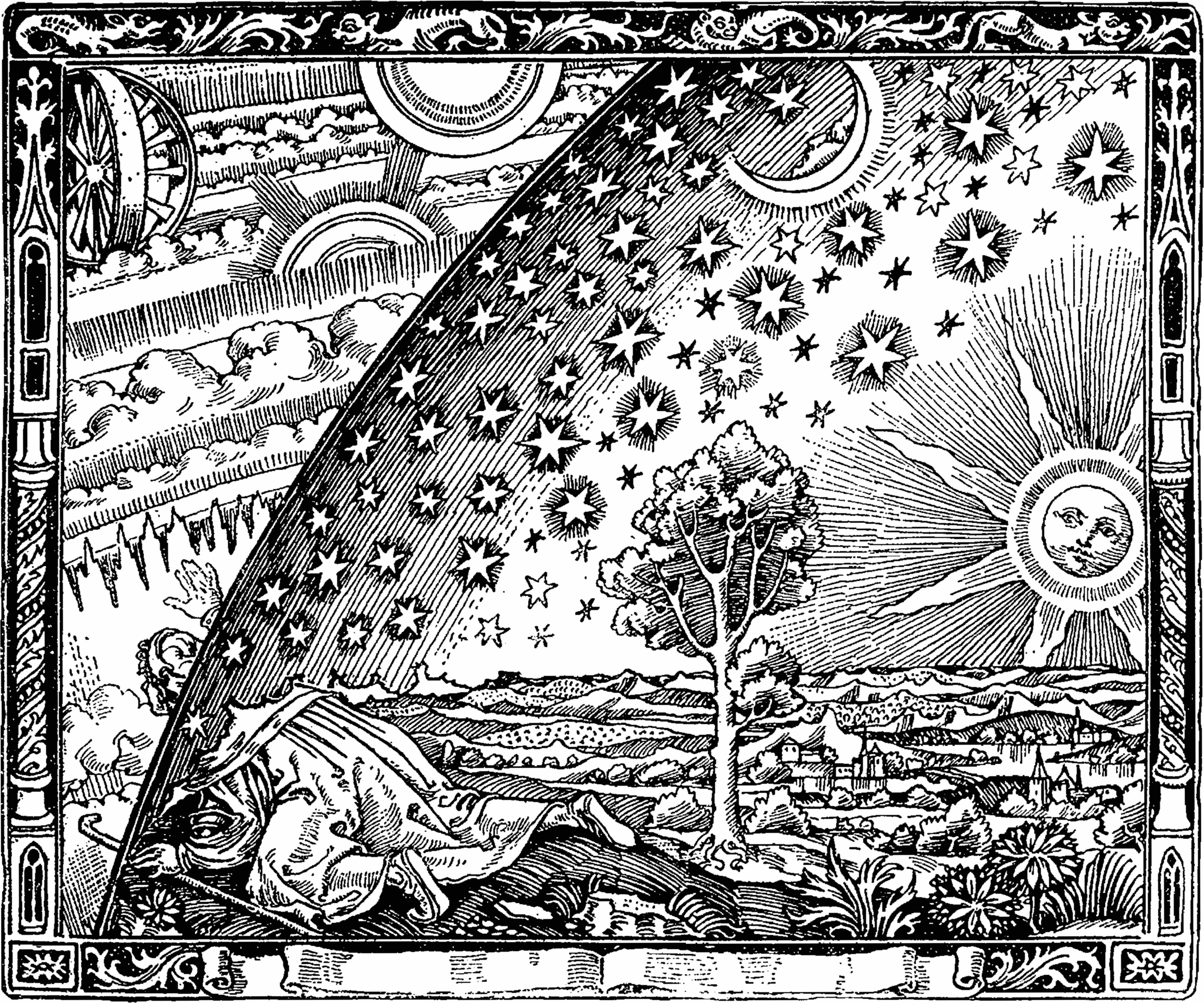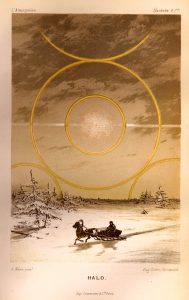
July 22, 2016, by Brigitte Nerlich
Camille Flammarion: Making science popular
Life on this planet is currently crazy, chaotic and confusing. In this context, I was thinking – wouldn’t it be nice to be able to poke one’s head out of the earthly firmament and look at the heavens beyond. This thought popped into my head because I had once seen an image depicting something like this many years ago in a book about the French astronomer and science populariser Camille Flammarion. Others might have seen it on wallpaper, on a T-shirt or in a comic. The image has become part of popular culture.
This set me thinking. Who was this Camille Flammarion and what about that image? So instead of sticking my head out into the heavens, I stuck my nose into the internet and searched out a few links about this 19th-century scientist. As usual, things turned out more fascinating than I had anticipated. The first thing I looked at was a Wikipedia article and my eyes fell on a rather comforting quote by Flammarion:
“What intelligent being, what being capable of responding emotionally to a beautiful sight, can look at the jagged, silvery lunar crescent trembling in the azure sky, even through the weakest of telescopes, and not be struck by it in an intensely pleasurable way, not feel cut off from everyday life here on earth and transported toward that first stop on the celestial journeys? What thoughtful soul could look at brilliant Jupiter with its four attendant satellites, or splendid Saturn encircled by its mysterious ring, or a double star glowing scarlet and sapphire in the infinity of night, and not be filled with a sense of wonder? Yes, indeed, if humankind — from humble farmers in the fields and toiling workers in the cities to teachers, people of independent means, those who have reached the pinnacle of fame or fortune, even the most frivolous of society women — if they knew what profound inner pleasure await those who gaze at the heavens, then France, nay, the whole of Europe, would be covered with telescopes instead of bayonets, thereby promoting universal happiness and peace.” — Camille Flammarion, 1880
From there I followed a trail of connections, which others have followed before me; so I’ll only highlight some of them. (If you want to know more about Flammarion from a more scholarly perspective, there is an article by Bernadette Bensaude-Vincent from 1989).
Flammarion – science writer and populariser
Nicolas Camille Flammarion was a 19th-century French astronomer. He studied double and multiple stars, the moon and Mars. He founded the Société astronomique de France. From 1882 onward he also published the magazine L’Astronomie which contributed to making astronomy public and a public enterprise. He wrote lavishly illustrated books on astronomy, including Astronomie populaire (1880), translated as Popular Astronomy (1894) and L’atmosphère: météorologie populaire (1888). In the last book we find the famous engraving pictured above. I’ll come back to that later.
He also wrote a popular book entitled Astronomy for Amateurs. The introduction to the 1904 American English edition reviews the contributions of many 18th- and 19th-century female contributors to astronomy. On page 2 Flammarion says: “Throughout the ages women have occupied themselves successfully with Astronomy, not merely in its contemplative and descriptive, but also in its mathematical aspects.”
In 1976, on the fiftieth anniversary of his death, scholars feted Flammarion’s work as the “beginning of modern science writing” and Popular Astronomy as a “first step in the popularization of science”. Among many other things, Flammarion made Mars public, so to speak, through his observations but also through his speculations. He famously attributed its red colour to vegetation and he “supported the idea of canals on Mars, and intelligent life, perhaps more advanced than earth’s.”
Flammarion’s writing career overlaps to some extent with that of Jules Verne who famously sent a fictional rocket train to the moon. However, while Verne never engaged in factual science writing, Flammarion engaged in fictional science writing as well as factual. And while Verne found inspiration for his novels in Le Magasin Pittoresque, Flammarion wrote for this popular magazine, as well as for others, such as Cosmos and Paris’s most important daily, the Siècle (Sherard, 1894; this article contains some nice photos of Flammarion and his first wife Sylvie, who was, by the way, a radical feminist and pacifist). (Cosmos, was a “revue encyclopédique hebdomadaire des progrès des sciences et de leurs applications aux arts et aux industries ». It borrowed its title from Alexander von Humboldt’s great work Cosmos!)
Flammarion – science fiction writer and spiritualist
While in Verne’s novels we might see strange but real creatures, in Flammarion’s we also find ‘aliens’. As pointed out in an article for an Astrobiology Magazine: “In both science and fiction, the alien infused the work of Camille Flammarion, infecting the intellectual life and popular culture of France. Flammarion’s notable calling as a science communicator began when he was a mere twenty years of age. La Pluralité des Mondes Habitées (The Plurality of Habitable Worlds, 1862) was a very successful study of the habitability of the planets of the solar system, going through thirty-six editions by 1892, and translated into at least six and possibly as many as fifteen languages.”
Two years later, in 1864, Flammarion wrote Les Mondes Imaginaires et Les Mondes Réels (Real and Imaginary Worlds). Speculations about aliens began to mingle with imaginations of aliens. In 1873 he published Récits de l’infini: Lumen, histoire d’une âme, histoire d’une comète; la vie universelle et éternelle (Tales of infinity: Lumen, a story about the soul, history of a comet; universal and eternal life).
Again, I found some interesting information about Lumen in particular in the article for the astrobiology magazine: “Written before the literary style of science fiction had been perfected by the likes of Verne and Wells, Lumen is based on the dialogic style of science communication, particularly Humphry Davy’s Consolations in Travel; or, The last Days of a Philosopher (1830) and Bernard le Bovier de Fontenelle’s Entretiens sur la Pluralité des Mondes (Conversations on the Plurality of Worlds, 1686). In Lumen, Flammarion was the first author to thoroughly apply the theory of evolution, albeit Lamarckian, to the creation of truly alien life forms, thereby laying one of the fundamental keystones to twentieth century science fiction”.
Going beyond possible alien worlds, Flammarion speculated (and here we enter the realm of pseudoscience rather than science fiction) in “the existence of the mind and consciousness independent of the living body”, a topic widely explored at the end of the 19th century. So it is not surprising that in 1900 he published a book entitled L’Inconnu et les problemes psychiques (The Unknown and psychic problems).

Solar halo in northern latitudes caused by ice crystal refraction. In: L’Atmosphère by Camille Flammarion, 1872. Library Call No. M0030 F581a 1872. NOAA Photo Library
Sebastian Normandin writes in The Allure of Pseudoscience that Flammarion “even wrote a novel about the end of the world (entitled La Fin du Monde [1893]), which was the inspiration for a movie in the early 1930s, anticipating such films as Armageddon and Deep Impact.” And of course there is much more that one could say….
Flammarion’s scientific and cultural impact went deep. This was due not only to his factual and fictional writing but also to the wonderful illustrations that accompanied his texts, some of which can be found in The National Oceanic and Atmospheric Administration’s Photo Library (612 onwards). Like Verne, Alexander von Humboldt (next blog post) and many many more, he contributed to making science visual and visible. And so we come to the famous engraving.
The Flammarion engraving
As the Wikipedia article on the engraving points out, “The Flammarion engraving is a wood engraving by an unknown artist that first appeared in Camille Flammarion‘s L’atmosphère: météorologie populaire (1888; p. 163). The image depicts a man crawling under the edge of the sky, depicted as if it were a solid hemisphere, to look at the mysterious Empyrean beyond. The caption underneath the engraving […] translates to ‘A medieval missionary tells that he has found the point where heaven and Earth meet’…”. The reader is then told that this is of course impossible. Interestingly, the universe imagined in the picture seems to be mechanised, as alluded to by the wheels in the top left corner.
This image has a long and complex cultural history which I can’t recount here. I only want to quote from one more blogger I found when trawling though the internet. In his blog Science-Fictionality Andrew R. Cameron says that the image captures “a society undergoing radical change, as older astronomical traditions are overthrown and new theories spring to life. Stars are revealed to be clockwork creations, governed by natural forces. You can feel the gears of history grinding away – paradigms are changing; our understanding of the Universe is evolving.”
Science and culture
We seem to be living through such a revolution right now. In this context we might want to re-read the long Flammarion quote again with which I started this post; together with Immanuel Kant who wrote, a century earlier, in his Critique of Practical Reason (1788): “Two things fill the mind with ever new and increasing admiration and reverence, the more often and steadily one reflects on them: the starry heavens above me and the moral law within me. I do not need to search for them and merely conjecture them as though they were veiled in obscurity […]; I see them before me and connect them immediately with the consciousness of my existence.” (CPrR5: 161-2; transl. Gregory)
No comments yet, fill out a comment to be the first

Leave a Reply